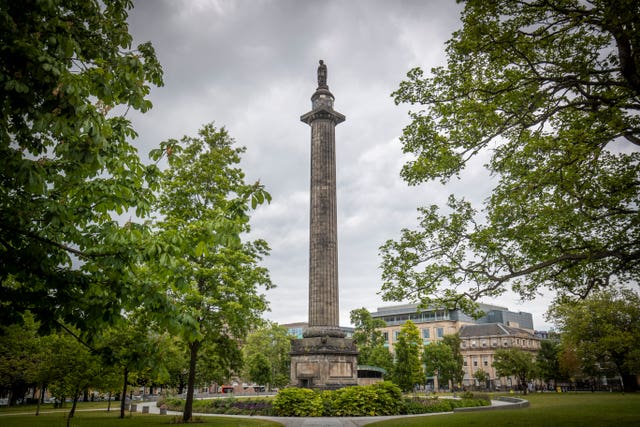A plaque will be installed at a monument in Edinburgh dedicated to a politician who delayed the abolition of slavery, after wording was agreed by the local authority.
Henry Dundas, 1st Viscount Melville, worked to frustrate efforts to end the trade by using his influence as home secretary, setting the move back 15 years.
A 150ft column with a statue of the politician – known as the Melville Monument – stands in St Andrew Square and was vandalised during the Black Lives Matter protest in the city on Sunday.
Council leader Adam McVey held a meeting of partners – including the site’s owners – and wording for the plaque was agreed, which will be published on Wednesday.
He said: “We have a lot to celebrate about the contribution black and ethnic minority Edinburghers have made and are making to our city’s progress and success, and that should be clear.
“We also need to address and talk openly about those moments in Scottish history where people have been killed, enslaved or discriminated against simply because of their race.
“I’m pleased to say that we’ve come to a form of words on a plaque at the statue of Henry Dundas – and this will be published tomorrow.”
He added: “It will be finalised and installed at the foot of the Melville Monument as soon as possible.
“This is just one part of Edinburgh’s history and one small change we can make.
“We should make many more.”

Dundas put forward an amendment to a Bill that would abolish slavery in 1792, opting for a more gradual approach.
This allowed the practice to continue for 15 years longer than it otherwise would have done.
During this time an estimated 630,000 people were transported to Britain as slaves.
Dundas was nicknamed “the Great Tyrant” and was later impeached for the misappropriation of public money in 1806.
The now A-listed monument was erected in 1823.
Mr McVey told BBC Radio Scotland’s Good Morning Scotland programme: “I would have absolutely no sense of loss if the Dundas statue was removed and replaced with something else or left as a plinth.
“I think it’s important to tell our story as a city, I think it’s important that that’s reflective, that’s representative of what actually happened – not what we might have wanted to happen – and I think we take that conversation from there.”
The bronze memorial to Edward Colston situated in Bristol city centre since 1895, was torn down after crowds left College Green as part of a Black Lives Matter demonstration pic.twitter.com/tXji2u20a5
— PA Media (@PA) June 7, 2020
Mr McVey’s comments came after campaigners pulled down the statue of slave trader Edward Colston in Bristol.
Graffiti was also scrawled on the monument to Sir Winston Churchill in Parliament Square, London.
On Tuesday, London Mayor Sadiq Khan announced the city’s landmarks will be reviewed to ensure they reflect the capital’s diversity.

He said the Commission for Diversity in the Public Realm will examine murals, street art, street names, statues and other memorials, and consider which legacies should be celebrated before making recommendations.
A second statue was also vandalised.
The statue of Robert Dundas, 2nd Viscount Melville, was also vandalised.
Robert, the son of Henry, was vandalised with graffiti saying “Son of slaver and Colonialist Profiteer”.




Why are you making commenting on The National only available to subscribers?
We know there are thousands of National readers who want to debate, argue and go back and forth in the comments section of our stories. We’ve got the most informed readers in Scotland, asking each other the big questions about the future of our country.
Unfortunately, though, these important debates are being spoiled by a vocal minority of trolls who aren’t really interested in the issues, try to derail the conversations, register under fake names, and post vile abuse.
So that’s why we’ve decided to make the ability to comment only available to our paying subscribers. That way, all the trolls who post abuse on our website will have to pay if they want to join the debate – and risk a permanent ban from the account that they subscribe with.
The conversation will go back to what it should be about – people who care passionately about the issues, but disagree constructively on what we should do about them. Let’s get that debate started!
Callum Baird, Editor of The National
Comments: Our rules
We want our comments to be a lively and valuable part of our community - a place where readers can debate and engage with the most important local issues. The ability to comment on our stories is a privilege, not a right, however, and that privilege may be withdrawn if it is abused or misused.
Please report any comments that break our rules.
Read the rules hereComments are closed on this article